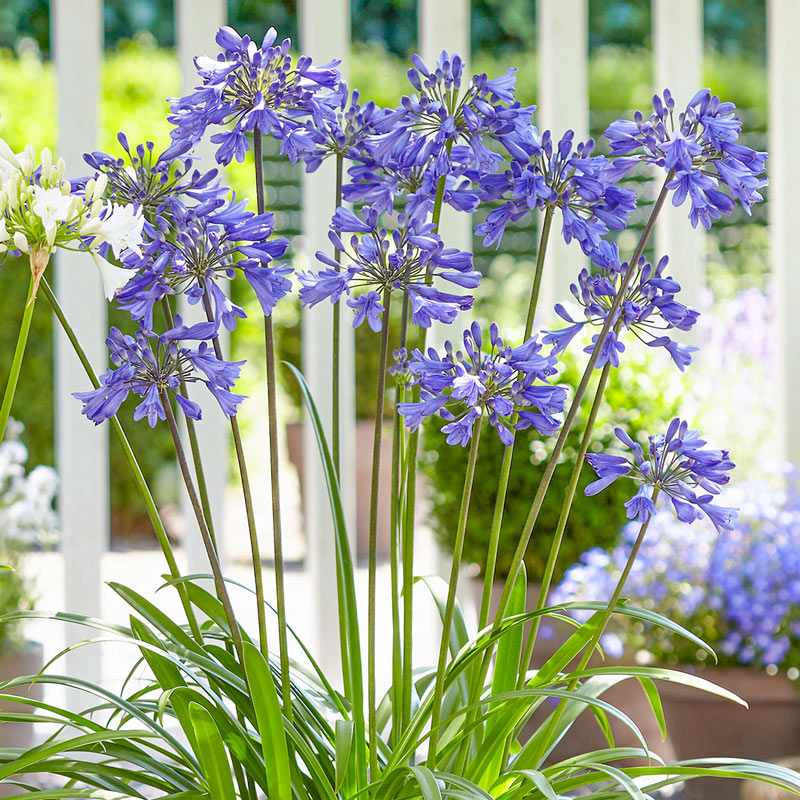Just how to Plant and Maintain Agapanthus in Your Garden
Just how to Plant and Maintain Agapanthus in Your Garden
Blog Article
Understanding the Art of Agapanthus Care: Important Steps for Healthy Development and Vivid Blossoms
In the world of horticulture, the farming of agapanthus stands as a satisfying endeavor for those that seek to nurture these stylish blooming plants. From choosing the ideal range to understanding trimming methods, the journey towards growing prospering agapanthus plants is multifaceted and holds the vital to unlocking the full capacity of these organic treasures.

Picking the Right Agapanthus Variety

When selecting the right Agapanthus selection for your garden, consider elements such as climate suitability, flower shade, and growth routine. Agapanthus, typically called Lily of the Nile or African lily, can be found in a range of shades ranging from tones of blue and purple to white. Choose a blossom color that enhances your existing garden combination to produce a harmonious landscape. Furthermore, consider the environment in your region to make sure the Agapanthus selection you pick can grow in your particular problems. Some varieties are a lot more tolerant of cool temperature levels, while others favor warmer climates. Comprehending the growth practice of various Agapanthus varieties is important for appropriate positioning within your yard. Some ranges have a clumping growth routine, ideal for borders or containers, while others have a more spreading nature, appropriate for ground cover or mass growings. By thoroughly examining these elements, you can choose the excellent Agapanthus selection to improve the elegance of your yard.
Suitable Planting Conditions
Taking into consideration the ideal ecological demands is crucial for successful Agapanthus growing. Agapanthus plants are sensitive to chilly temperatures and ought to be protected from frost throughout wintertime months.
To guarantee healthy and balanced development and vivid blooms, plant Agapanthus light bulbs at a deepness of concerning 2-4 inches and area them 8-12 inches apart. Including raw material, such as garden compost, to the dirt can enhance drain and fertility, promoting robust root growth. Mulching around the base of the plants helps preserve moisture and subdues weed growth. Regular watering is vital, specifically during the expanding period, to keep the dirt constantly damp but not waterlogged.
Watering and Fertilizing Tips
Keeping proper moisture levels and supplying essential nutrients are essential aspects in the care routine for Agapanthus plants. When it comes to sprinkling Agapanthus, it is vital to strike a balance. These plants like regularly damp dirt however are vulnerable to root rot if overwatered.
Feeding Agapanthus is necessary for advertising healthy growth and try these out prolific blooms. Use a balanced plant food, such as a 10-10-10 formula, in the very early spring as brand-new development arises. By complying with these watering and fertilizing ideas, you can guarantee your Agapanthus plants flourish and produce lively, resilient blossoms.
Trimming Strategies for Agapanthus
Trimming Agapanthus plants at the suitable times and with correct techniques is essential for preserving their health and wellness and advertising optimal development and blooming. The ideal time to trim Agapanthus is in late wintertime or very early springtime before new growth arises.
Deadheading invested blossoms can additionally reroute the plant's power into creating even more blooms rather than establishing seeds. If you want to gather seeds for propagation, leave some blossoms to completely dry and mature on the plant.
Remember to make use of tidy, sharp devices to make specific cuts and lower the danger of presenting conditions. Agapanthus. Normal trimming will aid keep your Agapanthus looking cool and healthy while making sure an abundant display of lovely flowers
Dealing With Typical Parasites and Diseases
After making sure appropriate pruning strategies for Agapanthus, it is vital to deal with common parasites and illness that can influence the health and wellness and vitality of these plants. One usual insect that impacts Agapanthus is the Agapanthus gall midget.
Additionally, Agapanthus plants can experience from origin rot if they are planted in inadequately draining dirt. By being this hyperlink cautious and taking punctual action against bugs and conditions, you can assist your Agapanthus plants thrive and create dynamic blooms. Agapanthus.

Verdict
Finally, grasping the art of agapanthus care includes choosing the ideal variety, offering ideal growing conditions, appropriate watering and feeding, proper pruning techniques, and resolving common parasites and conditions. By following these important actions, you can make sure healthy development and vivid flowers for your agapanthus plants. Bear in mind to regularly keep an eye on and preserve your plants to promote their overall well-being and long life.
To make sure healthy development and dynamic flowers, plant Agapanthus bulbs at a depth of regarding 2-4 inches and room them 8-12 inches apart. next By following these watering and fertilizing pointers, you can guarantee your Agapanthus plants flourish and generate dynamic, lasting flowers.
One typical bug that impacts Agapanthus is the Agapanthus gall midge. Furthermore, Agapanthus plants can suffer from origin rot if they are planted in improperly draining pipes soil. By following these crucial actions, you can ensure healthy development and lively blooms for your agapanthus plants.
Report this page